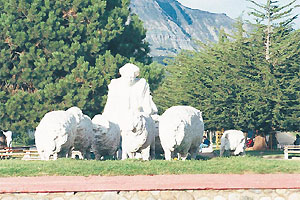We have already seen that our country’s unique shape conditions elements like climate, vegetation and even the distribution of the population. This also implies a huge challenge when it comes time to administer the available resources and ensure that the quality of life is equal from one end of the country to the other.
The role of the State is to ensure a correct organization and administration of the country, promoting measures that are aimed at the common good, in order to optimize he production of goods and services and strive for an efficient government administration.
If we go over our country’s history n the XX century, we can see that not just one, but several plans have attempted to organize the land. With the installment of the 1925 constitution, a division was established based on provinces and departments; it was only implemented fully in 1936 with the creation of 25 provinces, 97 departments and 200 comunas.
Between 1965 and 1968, the National Planning Office (Odeplan) conducted a study that proposed to split the country up into eleven regions and a metropolitan zone; each region was made up of a group of provinces. However, despite the fact that this new division emphasized each region’s economic development, once again there was not enough effort placed on an effective state (local) administration.
The definitive project
On September 17th, 1973, an initiative born form the military junta created the Administrative Reform National Commission (Conara), which was left with the important mission of perform an assessment of the territorial organization that was enforced in the country at the time, as well as a socioeconomic analysis of each of the regions in Chile.
The assessment revealed important data, which proved the huge inequality present in the delivery of services, administration and the economic development of each of the zones our country is split into. Therefore, it was necessary to create a new organization, so on July 8th, 1974, the country was arranged into 12 administrative regions, plus one metropolitan area. This way, not only was there a new territorial organization en force, but also a new administrative political system that fit this model. In the first stage, five pilot regions were created (I, II, VIII, XI, XII), which were the the ones at the far ends and the region of Biobio, due to its multi-provincial nature and its economic and infrastructural potential. In 1976, after making sure there was positive evidence, the regionalization spread throughout the land, establishing the twelve regions plus the metropolitan area for good.
In 1978 they received the name they bear to this day, and one year later, the process reached its conclusion when the new divisions’ borders were established.
A new regional outlook
The Constitutional reform taken place in 2005 modified the total amount of regions that make up the country. That very year, the government presented Congress with a bill to create two new regions: the region of Arica y Parinacota (which corresponds to the provinces of Arica y Parinacota from the region of Tarapaca) and the region of los Rios (which is comprised of the provinces of Valdivia and Ranco from the region of los Lagos).
The creation of these two new regions will deal with specific needs from each zone. In the case of the north, the birth of Arica y Parinacota settles an old score with the population, which felt left out and needed a boost in order to once again become an important development pole, like tourism and mining.
Meanwhile, the region of los Rios was created to increase investment in the area (forestry, farming and livestock), even benefiting activities like tourism and the service industry.
On March 16th, 2007, president Michelle Bachelet ratified the creation of the XIV region of los Rios and its provinces through Law 20,174.
Later, on March 23rd, the creation of the XV region of Arica y Parinacota was formalized through Law 20,575.
Territorial divisions
Regions are the largest territorial units. They have their own geographical characteristics and their socioeconomic and cultural interests are more or less similar and they have a population large enough to sustain economic activities aimed towards their development.
Their administrative center is the regional capitol and their top authority is the intendant, who is appointed by the president of the Republic (the intendant is their direct representative in the region). In addition, the regional government is made up of ministerial secretaries (seremis), who represent the misters and work alongside the intendants in the elaboration and execution of projects.
At the same time, the region is comprised of an intermediate territorial unit called a province. It is made up of a set of urban and rural centers that are connected and which converge in a main unitary center. In addition, it has enough equipment to meet the requirements of the population that lives there. Its top authority is the governor, who proposes, supervises and executes plans that promote provincial development.
Finally, the comuna (county) is the smallest unit. Its objective is providing a more direct administration, one that is closer to the inhabitants of a specific sector and their borders are based on the specific socioeconomic needs characteristics and needs of the place’s inhabitants.
The administration of comunas is in the hand of municipalities, autonomous entities that do not answer directly to the president of the Republic and have their own legal personality and assets. Each municipality is headed up by a mayor, who is elected through a popular vote and runs the Municipal Council along with councilmen, who are also elected by the community.








 Muere Leonardo da Vinci
Muere Leonardo da Vinci